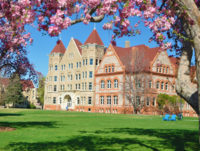The University of Colorado Boulder’s Baker Hall, closed for the past 15 months for its first major renovation in more than 75 years, welcomed 456 students in late August with a modernized interior that better addresses the needs of today’s students while retaining the building’s original charm.


“The 1937 Baker building, the second-oldest residence hall at CU-Boulder, represented an exciting design challenge,” said Thomas Goodhew, assistant director of planning at CU Boulder. “The renovation needed to modernize while honoring the building’s rich architectural style created by Charles Klauder. His vision set the campus aesthetic that we enjoy to this day.”
Klauder, who was known for his architectural work on university campuses across the country, designed 15 CU-Boulder buildings between 1920 and 1938, including Baker and Sewall Hall. Other CU-Boulder fixtures that he designed include Norlin Library, the University Club and the Economics Building.
Student input and creative architectural design helped to meld the eras and preserve elements in the Baker renovation, such as ornate iron light fixtures, fireplace facades, decorative woodwork, stone and roof tiles, Goodhew said.
The contractor for the Baker project was the Denver office of Whiting-Turner Contracting Co. and the architect was Aller Lingle Massey Architects, Fort Collins.
In-House RAPPers
All of the residents are participating in the Baker Residential Academic Program (RAP) held in the building. CU-Boulder has 14 RAPs, programs that integrate courses, educational opportunities and social events among classmates within residence halls, along with a high level of faculty engagement.
The Baker RAP is for first- and second-year undergraduates in natural sciences, pre-health and environmental studies. It also offers classes that fulfill core graduation requirements such as political science, philosophy and anthropology.
Some of the 18 courses taking place in the Baker RAP this fall will be in geology, environmental studies, biology, chemistry and weather and the atmosphere, said Cindy Carey, director of the Baker RAP.
“In addition to formal courses, we provide co-curricular adventures that emphasize nature and the environment such as rock climbing, backpacking, volunteer activities and internships,” said Carey. “And we’ve tied the RAP theme into the building renovation, naming the floors of Baker after environments such as ocean, mountain and desert.
“There are visual cues that go along with each floor’s environment, like subtle paint colors, photographs and quotes on display from various people about the value of nature and the importance of protecting the environment,” she said.
Not only do the visual cues of the floors build awareness, but they also help with way-finding, distinguishing various locations in the building from each other, according to Goodhew.


